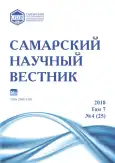Подход к оценке синантропных свойств видов
- Авторы: Федорова Л.В.1, Купатадзе Г.А.2, Куранова Н.Г.2, Викторов В.П.2, Ежкова В.Г.3
-
Учреждения:
- Первый Московский государственный медицинский университет имени И.М. Сеченова
- Московский педагогический государственный университет
- Государственный гуманитарно-технологический университет
- Выпуск: Том 7, № 4 (2018)
- Страницы: 126-133
- Раздел: 03.02.00 – общая биология
- URL: https://bakhtiniada.ru/2309-4370/article/view/21864
- DOI: https://doi.org/10.17816/snv201874122
- ID: 21864
Цитировать
Полный текст
Аннотация
Обсуждается различие подходов к определению активности вида при фитоценотических и флористических исследованиях. Предложена формула для оценки синантропных свойств вида с учетом встречаемости и обилия вида в экотопах с различной антропогенной трансформацией. Проведен интегральный анализ синантропных свойств 32 видов травянистых растений флоры города Орехово-Зуево в 19 наиболее распространенных типах экотопов, относящихся к трем категориям антропогенной нарушенности. Выделено 6 групп видов как по экотопической, так и по синантропной пластичности. Обсуждается соотношение экотопической пластичности и синантропности видов. Показано, что синантропные свойства видов зависят от широты экотопической приуроченности видов, но не полностью с ней совпадают. Аборигенные виды с высоким индексом экотопической пластичности успешно осваивают разнообразные, в том числе и сильно трансформированные экотопы, и формируют факультативно синантропную составляющую локальной флоры, которая постоянна и независима от степени трансформации среды. Адвентивные виды, даже обладая высокой экотопической пластичностью, с большим трудом проникают в слабо нарушенные экотопы и по большей части остаются облигатными синантропами. Аборигенные виды обладают более высокой синантропной пластичностью. Выявлен сходный диапазон варьирования индексов экотопической и синантропной пластичности у условно синантропных и несинантропных видов, что указывает на лабильность границ этих групп.
Ключевые слова
Полный текст
Открыть статью на сайте журналаОб авторах
Любовь Валерьевна Федорова
Первый Московский государственный медицинский университет имени И.М. Сеченова
Email: fedorova-oz@yandex.ru
старший преподаватель кафедры фармацевтического естествознания
Россия, МоскваГалина Александровна Купатадзе
Московский педагогический государственный университет
Email: kupatadze_galina@mail.ru
кандидат биологических наук, доцент кафедры ботаники
Россия, МоскваНаталия Геннадиевна Куранова
Московский педагогический государственный университет
Email: nkuranova@inbox.ru
кандидат биологических наук, доцент кафедры ботаники
Россия, МоскваВладимир Павлович Викторов
Московский педагогический государственный университет
Email: vpviktorov@mail.ru
доктор биологических наук, профессор, заведующий кафедрой ботаники
Россия, МоскваВалентина Геннадьевна Ежкова
Государственный гуманитарно-технологический университет
Автор, ответственный за переписку.
Email: eva3015@yandex.ru
кандидат педагогических наук, доцент кафедры экономики, управления и бизнеса
Россия, Орехово-Зуево, Московская областьСписок литературы
- Jalas J. Hemerobe und hemerochore Pflanzenarten. Ein terminologischer Reformersuch // Acta Societia Pro Fauna et Flora Fennica. 1955. Vol. 73. P. 1-15.
- Ишмурзина М.Г., Барлыбаева М.Ш. Гемеробиальность синантропных и синантропизированных растительных сообществ Южно-Уральского заповедника // Вестник Удмуртского университета. Серия «Биология. Науки о Земле». Т. 25, вып. 2. 2015. С. 77-81.
- Kunick D. Zonietung des Stadtgebietes von Berlin (West). Ergebnisse Floristischer Untersuchung // Gen. Schriftenr. d.Fachber. Landschaftsentwicklung u. Umweltforsch. № 14. P. 1-164.
- Frank D., Klotz S. Biologisch-oekologische Daten zur Flora DDR. Martin Luther Universitaet, Halle-Wittenberg, 1990. 167 s.
- Jackowiak B. The hemeroby concept in the evaluation of human influence on the urban flora of Vienna // Phytocoenisis. 1998. Vol. 10. P. 79-96.
- Hill M.O., Roy D.B., Tompson K. Hemeroby, urbanity and ruderality: bioindicators of ditrurbance and human impact // Journal of Applied Ecology. 2002. Vol. 39, № 5. P. 708-720.
- Wittig R., Diesing D., Gödde M. Urbanophob - Urbanoneutral - Urbanophill. Das Verhalten der Arten gegenüber dem Lebensraum Stadt // Flora. 1985. № 177. P. 265-282.
- Sudnik-Wojcikowska B. Studies on Indices of Flora Synanthropization // Flora. 1992. Vol. 187. P. 37-50.
- Фрей Т.Э.-А. Некоторые аспекты фитоценотической значимости вида в растительном сообществе // Ботанический журнал. 1966. № 8. С. 1073-1084.
- Жукова Л.А.Экологические шкалы и методы анализа экологического разнообразия растений. Йошкар-Ола: Марийский государственный университет, 2010. 368 с.
- Юрцев Б.А. Флора Сунтар-Хаята. Л.: Наука, 1968. 236 с.
- Юрцев Б.А. О количественной оценки «веса» видов при флористическом районировании // Ботанический журнал. Т. 68, № 9. 1983. С. 1145-1152.
- Малышев Л.И. Флористическое районирование на основе количественных признаков // Ботанический журнал. Т. 58, № 11. 1973. С. 1581-1588.
- Ильминских Н.Г. Понятие «активность видов» и его место среди методов изучения растительного покрова // Растительный покров антропогенных местообитаний: сб. науч. трудов. Ижевск, 1988. С. 25-36.
- Дидух Я.П. Проблемы активности видов растений // Ботанический журнал. Т. 67, № 7. 1982. С. 925-935.
- Дидух Я.П. Анализ эколого-ценотической дифференциации растительного покрова горного Крыма // Ботанический журнал. № 8. 1988. С. 1168-1178.
- Бабич Н.А., Ушакова С.Н. Активность видов сегетальной флоры питомников южнотаежной подзоны Вологодской области // Вестник Северного (Арктического) федерального университета. Серия «Естественные науки». Вып. 2. Архангельск, 2012. С. 5-10.
- Коновалова И.С., Бабич Н.А., Марич С.Н. Фитоценотическая значимость сорных растений лесных питомников // Лесной журнал. 2014. № 1 (337). С. 37-45.
- Раков Н.С. Состав, структура и динамика адвентивной флоры Ульяновской области: автореф. дис. … канд. биол. наук. Тольятти, 2012. 19 с.
- Наткевичайте-Иванаускене М.П. Количественные соотношения встречаемости и константности групп видов в растительных сообществах // Биологические науки. № 8. 1985. С. 63-68.
- Федорова Л.В., Купатадзе Г.А., Куранова Н.Г., Викторов В.П. Классификация городских экотопов в связи с изучением синантропности (на примере города Орехово-Зуево) // Социально-экологические технологии. 2017. № 1. С. 52-63.
- Василевич В.И. Статистические методы в геоботанике. М.: Наука, 1969. 232 с.
- Статистика: учебно-практическое пособие / под ред. М.Г. Назарова. 2-е изд. стер. М.: КНОРУС, 2008. С. 26-33.
Дополнительные файлы






